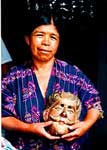|
The following morning we set out on the most dramatic leg of our trip, over the spine of the Chuchumatanes, the highest mountains in Central America, over 13,500 feet high. Our destination, Nebaj, is one of three main towns that form the Ixil triangle.
Our bus climbs only ten miles an hour on the steep unpaved twisted roads. We are mesmerized by the mountains, giant petrified waves cutting across the earth. Occasionally we see men and women working the almost vertical terraced gardens, scampering from one level to the next.
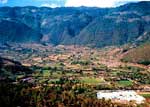 Carl points out the usual and the unusual sights: the Maya ritual altars made of evergreen branches and dried flowers placed next to fields of new corn; a Mayan sauna called a choo, a squat outhouse-looking structure we see more often the higher we climb. Carl points out the usual and the unusual sights: the Maya ritual altars made of evergreen branches and dried flowers placed next to fields of new corn; a Mayan sauna called a choo, a squat outhouse-looking structure we see more often the higher we climb.
In El Quiche province, near the town of Uspantan, we choose a place off the road to picnic which, Mike notes, is not far from the birthplace of Rigoberto Menchu, the l992 Nobel Peace Prizewinner. As an older Indian and his goats and cows pass, I think of the amazing and dangerous journey Menchu took from her tiny nearby hamlet to the world stage, exposing the atrocities of the Ladinos and Guatemalan government against her people, while fighting for recognition of her culture.
Three miles from Nebaj, we stop for a young woman and her two children going our way. The woman carries her infant in a sling across her chest, while the other child, about four, with a runny nose and coughing, walks beside her. She tells Mike they are returning from a trip to a medical clinic, an all-day hike.
We enter the town through narrow streets of another time, and stop once to allow a man to recapture his runaway donkey jinxed by our bus. In the town's center, marked by an old colonial church built on a rise, we sense all the beauty and darkness described in Latin American novels. Young girls with open smiles and dressed in the traditional skirts and huipiles, gather, giggling in the square, a few with backpacks. Elders sit, relaxed, talking, as several boys in modern button-down shirts and pants rush by holding black and white soccer balls. No one seems fazed when a couple of armed government policemen in camouflage cross the far edge of the square dragging a man in handcuffs.
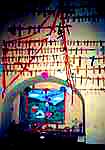 On our way to breakfast the next morning, we first stop to visit the church. As we enter, children's laughter and the warmth of the sun creep in behind us. Our eyes adjust to the hazy light in a large room that looks almost festive with a couple of lacy white banners strung from either side and up to the ceiling above the pews, when we are suddenly riveted by a sight to our right. On our way to breakfast the next morning, we first stop to visit the church. As we enter, children's laughter and the warmth of the sun creep in behind us. Our eyes adjust to the hazy light in a large room that looks almost festive with a couple of lacy white banners strung from either side and up to the ceiling above the pews, when we are suddenly riveted by a sight to our right.
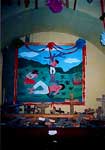 Painted on the wall are two Indian men, blood spewing from their naked torsos, one hung, the other shot, while a woman in native dress kneels between them, mourning. The innocence of the style, a kind of folk art, is itself a disturbing contrast to what the painting portrays. The rest of the wall, above the painting and up to the high ceiling, is covered with hundreds of handmade wooden crosses, each carrying the name, and sometimes the birth and death date, of a man, woman, or child killed in the massacres of the past three decades. More crosses are piled chillingly on a long wooden altar beneath the painting. Painted on the wall are two Indian men, blood spewing from their naked torsos, one hung, the other shot, while a woman in native dress kneels between them, mourning. The innocence of the style, a kind of folk art, is itself a disturbing contrast to what the painting portrays. The rest of the wall, above the painting and up to the high ceiling, is covered with hundreds of handmade wooden crosses, each carrying the name, and sometimes the birth and death date, of a man, woman, or child killed in the massacres of the past three decades. More crosses are piled chillingly on a long wooden altar beneath the painting.
Even Mike is surprised by what we see, illegal until now. But the Indians themselves, he says, have lived in denial of the masses killed over the years, and the painting demonstrates that they are beginning to deal with these horrible events, a first step in the healing process.
Later that morning, while we drive to the surrounding towns, we come upon a camp enclosed by a high barbed-wire fence. We stop. Thanks to an earlier newspaper report, we realize that this is one of the nine United Nations sites set up to facilitate the disarming of the rebels. A white UN van comes and goes followed by a van marked with the European Community emblem, a circle of purple stars.
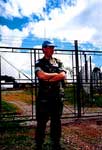 Eventually a man in a camouflage outfit approaches, hearing our American accent, and calls out to us in English. He's one of only five people from the United States stationed in Guatemala. He works with troubled boys back home in Utah, and was pulled from the navy reserves for this mission. He's enthusiastic and speaks Spanish. Eventually a man in a camouflage outfit approaches, hearing our American accent, and calls out to us in English. He's one of only five people from the United States stationed in Guatemala. He works with troubled boys back home in Utah, and was pulled from the navy reserves for this mission. He's enthusiastic and speaks Spanish.
But what he doesn't know surprises us. He is a weapons expert, but he is ignorant about the country and the people. Until a few days ago, he didn't know where Guatemala was, that there was a war here or what the people were fighting about.
I can't help wondering why we can't find five people in our vast country who have knowledge about Guatemala and about weapons. True, the mission here is to disarm the rebels. But this is also the location, according to the UN representative and subsequent newspaper reports, where the rebels will be re-educated in two or three months to fit back into society. A complicated process, considering that many of these young men and women have only known a rebel way of life. And as far as the rebels getting work, a stated priority in the process of resettlement, there is little employment available in this area no matter who you are.
After we return home, a May 6 article in the New York Times reports Guatemalan farmers rejected "a plan to resettle former guerrillas in their town... Some 300 residents threatened to burn down their houses..."
|
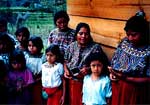 |
|
|
|
Women looking at poloroid photos of themselves at Acuna, near the resettlement camp
|
|
|
|
|
|
|
This is not the first time problems of resettlement have arisen. I think back to the discussions with Carl and Mike about technology and the wonders of the modern world and can't believe the world doesn't have a better plan; a more efficient model that could help solve these kinds of problems, not simply contain them. I worry that instead of learning from past mistakes on how to improve human relationships, the more modern countries don't find these situations important enough to direct the very human and economic resources we're saying are so necessary to the world.
Our trip passes too quickly, almost over. But before we leave Guatemala, we finally get to Chichicastinango. The largest tourist market in Guatemala, it is also a center of Indian culture, where the Popovu, the Indian bible, was discovered.
|
|

 Part 6
Part 6 Carl points out the usual and the unusual sights: the Maya ritual altars made of evergreen branches and dried flowers placed next to fields of new corn; a Mayan sauna called a choo, a squat outhouse-looking structure we see more often the higher we climb.
Carl points out the usual and the unusual sights: the Maya ritual altars made of evergreen branches and dried flowers placed next to fields of new corn; a Mayan sauna called a choo, a squat outhouse-looking structure we see more often the higher we climb. On our way to breakfast the next morning, we first stop to visit the church. As we enter, children's laughter and the warmth of the sun creep in behind us. Our eyes adjust to the hazy light in a large room that looks almost festive with a couple of lacy white banners strung from either side and up to the ceiling above the pews, when we are suddenly riveted by a sight to our right.
On our way to breakfast the next morning, we first stop to visit the church. As we enter, children's laughter and the warmth of the sun creep in behind us. Our eyes adjust to the hazy light in a large room that looks almost festive with a couple of lacy white banners strung from either side and up to the ceiling above the pews, when we are suddenly riveted by a sight to our right. Painted on the wall are two Indian men, blood spewing from their naked torsos, one hung, the other shot, while a woman in native dress kneels between them, mourning. The innocence of the style, a kind of folk art, is itself a disturbing contrast to what the painting portrays. The rest of the wall, above the painting and up to the high ceiling, is covered with hundreds of handmade wooden crosses, each carrying the name, and sometimes the birth and death date, of a man, woman, or child killed in the massacres of the past three decades. More crosses are piled chillingly on a long wooden altar beneath the painting.
Painted on the wall are two Indian men, blood spewing from their naked torsos, one hung, the other shot, while a woman in native dress kneels between them, mourning. The innocence of the style, a kind of folk art, is itself a disturbing contrast to what the painting portrays. The rest of the wall, above the painting and up to the high ceiling, is covered with hundreds of handmade wooden crosses, each carrying the name, and sometimes the birth and death date, of a man, woman, or child killed in the massacres of the past three decades. More crosses are piled chillingly on a long wooden altar beneath the painting. Eventually a man in a camouflage outfit approaches, hearing our American accent, and calls out to us in English. He's one of only five people from the United States stationed in Guatemala. He works with troubled boys back home in Utah, and was pulled from the navy reserves for this mission. He's enthusiastic and speaks Spanish.
Eventually a man in a camouflage outfit approaches, hearing our American accent, and calls out to us in English. He's one of only five people from the United States stationed in Guatemala. He works with troubled boys back home in Utah, and was pulled from the navy reserves for this mission. He's enthusiastic and speaks Spanish.
